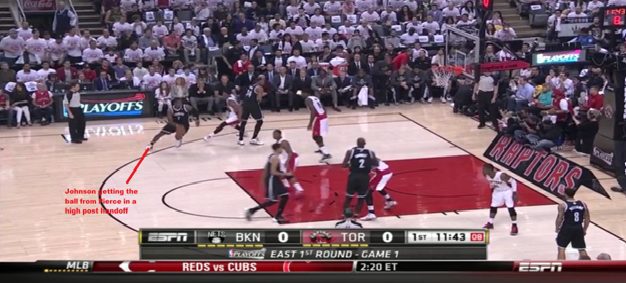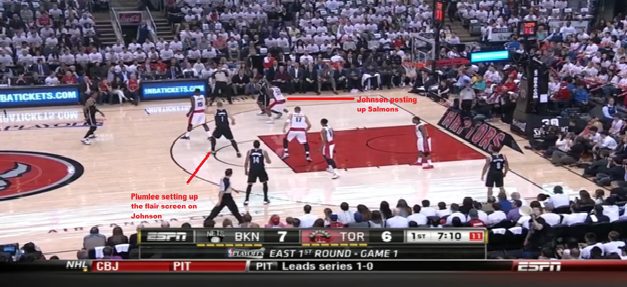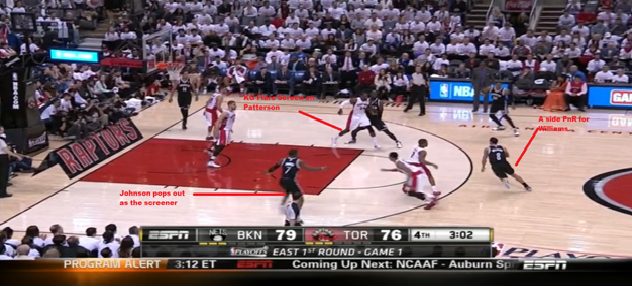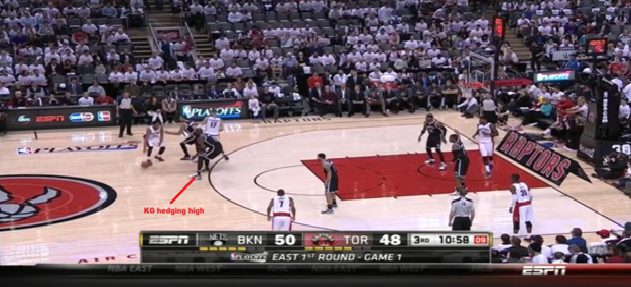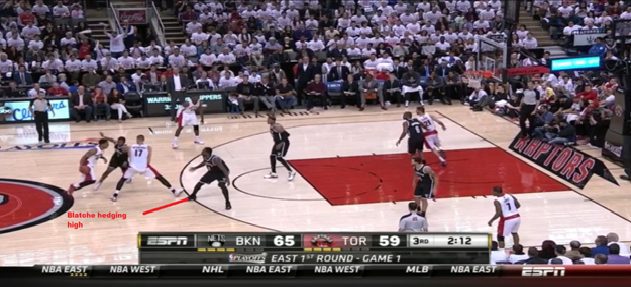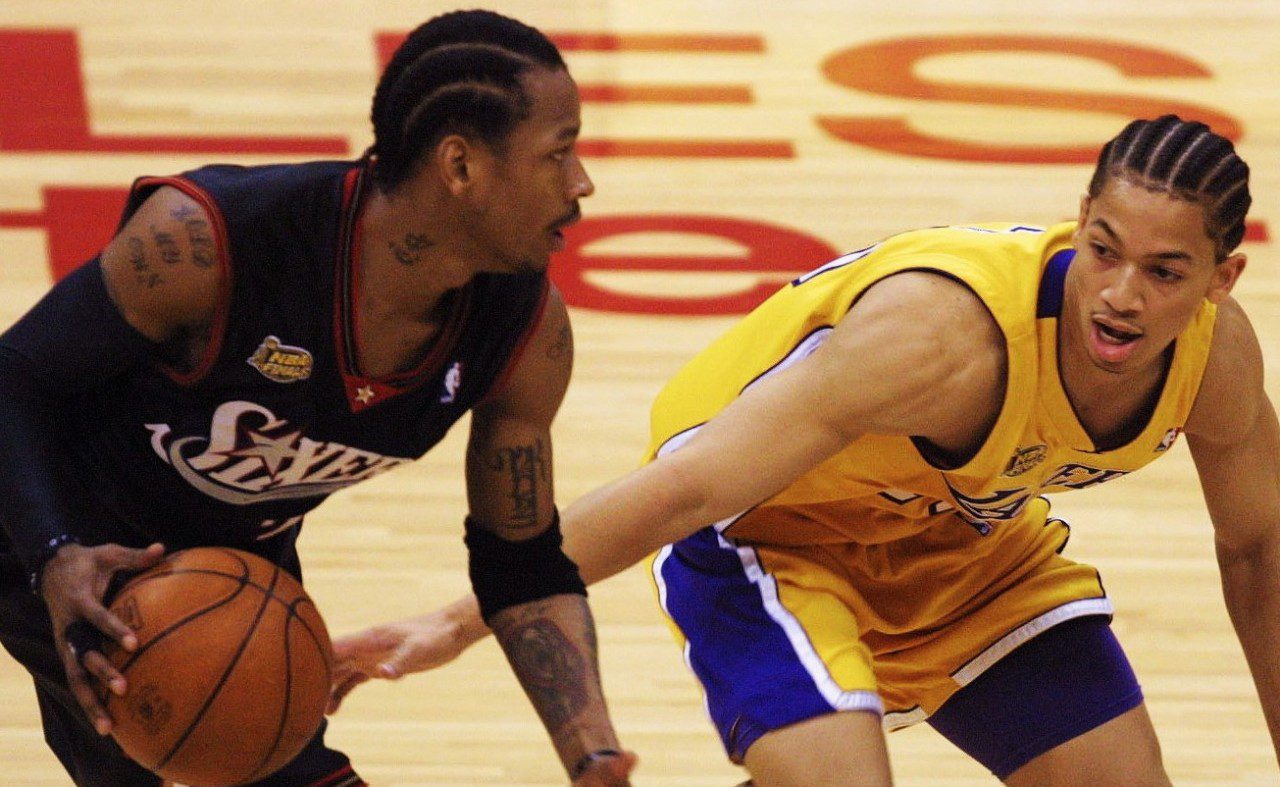Game one, to borrow a cliché is “a feeling out process.” The Brooklyn Nets and Toronto Raptors played like two teams feeling each other out, akin to boxers just throwing jabs in the middle of the ring for a prolonged period. The Nets won 94-87 in the first playoff game for the Raptors since 2008. You could hear and feel the appetite for playoff basketball at the ACC, with the TV production panning to a jam-packed Maple Leafs Square just outside. There was a bunch of secondary subplots; the experience discrepancy between the two teams, the emphasis on the perimeter matchups for both teams and the hybrid lineups the Nets employ consistently. A few things to note from Game 1:
Iso-Joe continues his form
The Raps had their fair share of problems guarding Joe Johnson, which isn’t too unfamiliar from what happened after the NBA All-Star break for the rest of the NBA. Johnson was uber-efficient, posting a 59.2 TS% on a 23.9 USG%. He helped get Terrence Ross, the Raptors most electric perimeter defender, into foul trouble, and it wasn’t just post-ups with the Nets according to Synergy Sports went only 1-for-4 from the field vs Toronto in Game 1. The Nets got Iso-Joe on the move through simple pin downs and flare screens, getting the Raptors perimeter players off their heels and on the move.
This instance wasn’t a post-up for Johnson, but rather for Paul Pierce in the high post. One of the more intriguing matchups for the series is Pierce vs. Amir Johnson because of the effect Pierce has as a power forward, and the Nets in this possession ultimately use Pierce at the high post-up as a decoy for a hand off/screen and roll:
This ultimately got the Nets an open look for Pierce in the corner, combining the advantages Pierce has with his ability to spot up as a 4 with Johnson’s capabilities with raising up for his 10-15 foot shots, especially on the move. If there’s something for the Raps to be worried about, it’s that the Nets shot only 7-for-24 from the field, and the Nets got makeable opportunities when the shots presented themselves. It’ll be interesting to see how the Raps counter the problem Joe Johnson presents for their wings. John Salmons, when Ross was on the bench, had his chances to guard Joe Johnson and Johnson exploited that matchup as well. Perhaps the Raps just simply live with the results, hoping that Johnson simply misses some of the shots he made in Game 1.
Pierce at the 4:
I wrote about the Nets right around when they committed to their version of small ball with Pierce at the 4 in January, and the matchup between Pierce and the Raps power forwards presented itself once again. For the most part, the Raps got off the hook with Pierce only scoring 15 points on 6-for-13 shooting. But there’s warning signs for this matchup, with Pierce’s ability to make outside shots giving Johnson and Patrick Patterson trouble, especially when the Nets ran flare screens for Pierce:
The second of these instances results in a back-breaking three-point shot for Pierce. The Nets also used him a couple of times as a screen in a pick and roll. Pierce had his fair share of success versus the Raptors during the regular season, and his advantages showed up in spurts. He lured Johnson and Patterson outside the paint, and he’s punished the Raps down the stretch with his ability to create shots still at an efficient level. Like the Joe Johnson situation vs the Raps wing players, I’m not exactly sure how the Raps will counter this unless Toronto goes small ball, which they haven’t had much experience with. The Raps this season almost always had lineups with two “prototypical” big man on the court, so straying from that to counteract Pierce at the four doesn’t seem to be in the game plan. It’ll be up to Johnson and Patterson to do a good enough job in showing and recovering vs Pierce or else the damages inflicted by Pierce could be much much worse.
Deron Williams factor:
Williams was a force in the first half, punishing the Raptors in semi transition whenever the Nets pushed the pace. There were a couple of possessions where Greivis Vasquez had to guard Williams as part of the Raps going with a two point guard backcourt in part due to Ross’s foul trouble, and that didn’t end well at all for Vazquez. There’s a lot to like about Vazquez’s game offensively in game 1, but he stood no chance in being able to keep up with William’s assortment of cross overs and hesitation moves.
The Raptors pushing the tempo
For all the athleticism that the Raptors have, they ranked in the bottom ten in Pace during the season according to NBA.com, and the game overall was played at a Pace of 93.44, right around where Brooklyn wants the game to be played. The Raps did very well in transition and according to Synergy Sports, Toronto shot 9-for-13 in transition on 16 possessions. The Raps during the regular season had identical Pace numbers whether they won or lost, and they actually played at a lower tempo since the All-Star break as well. It would perhaps be interesting for Toronto to experiment some more with quick tempo pick and rolls for Kyle Lowry and, to a lesser extent, for Terrence Ross (assuming that he can find a way to avoid early foul trouble), particularly with his ability to hit threes in these situations. It would accentuate both of Lowry’s best and worst attributes but the risk/reward would be beneficial.
DeRozan’s struggles:
Perhaps the biggest benefit for the Nets and their hybrid lineups is their ability to disrupt and switch assignments because of their length. Their length offsets, to some extent, the size problems when Pierce or any of their wings play the power forward position. DeMar DeRozan shot 3-for-12 from the field in his playoff debut, and nine of the shots were contested via NBA.com’s player tracking data. The Nets use a fairly aggressive style in screen and roll situations, with their big man hedging fairly high.
DeRozan has improved with his ability to go around the big man hedging, but he played a lot like the DeMar DeRozan that struggled in his first four years, having problems getting around said hedging big man. The Nets forced him into contested shots in isolation, with Shaun Livingson and a rotating set of wings doing a great job in using their length to dictate the matchup. Expect the Raps to diversify DeRozan’s possessions and have him set up more in hand off and offscreen plays, with DeRozan during the regular season having 15.7 percent of his possessions come via off screen situations from Synergy Sports though the Nets can make that difficult as well with their ability to switch.
The Nets and Raptors don’t play again until Tuesday night, and with the amount of scouting that goes on in playoff series, you’d expect both teams to exploit some of the tendencies that the teams showed in Game 1. The Raps only had eight offensive rebounds with a +1 offensive rebound differential versus Brooklyn. The Nets would gladly take that for Game 2 with the Nets during the regular season ranking 28th in DRB% while the Raps were above league average in ORB%. Whether the Raps go small to counteract the space that the Nets can employ with their lineup configuration is something we’ll have to see. Toronto will have to improve significantly in controlling their turnovers, especially if the tempo of the game ramps up. Game 1 was fun and hopefully Game 2 will give fans the same type of theatre.
Featured image courtesy of Keith Allison/Flickr.


